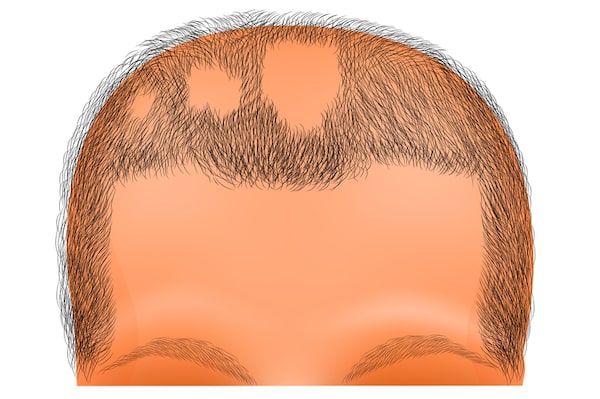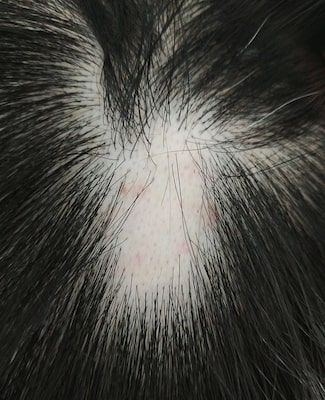 Alopecia Areata is a common autoimmune disorder that can result in an unpredictable amount of hair loss for the person suffering from the disease. Some people experience hair loss that is seen as small patches on the scalp around the size of a coin while others experience a more extreme form of hair loss such as complete loss of hair on the scalp (and even hair loss on the body). Let’s take a look at the causes of this hair loss condition as well as some possible treatment options.
Alopecia Areata is a common autoimmune disorder that can result in an unpredictable amount of hair loss for the person suffering from the disease. Some people experience hair loss that is seen as small patches on the scalp around the size of a coin while others experience a more extreme form of hair loss such as complete loss of hair on the scalp (and even hair loss on the body). Let’s take a look at the causes of this hair loss condition as well as some possible treatment options.
Alopecia Areata Facts
Both men and women can suffer from this autoimmune disease. The immune system makes antibodies along with white blood cells to protect the body against viruses and bacteria. The immune system perceives the viruses and bacteria to be foreign objects so an autoimmune disease is when the immune system mistakes parts of the body to be foreign objects.
Alopecia Areata is when the white blood cells that gather around the hair follicles are seen as foreign and this can result in bald patches being created by the hair falling out.
Thankfully, the impacted hair follicles are able to produce normal hair again when, and if, the autoimmune disease become less severe or intense.
Alopecia Areata Treatment
There are multiple treatment options used by doctors to treat the loss of hair from this condition:
- Corticosteroids, which are anti-inflammatory drugs that can suppress the immune system, can be administered orally, through injections or applied as a topical ointment
- Minoxidil can also be applied to the scalp to promote hair regrowth
- Some doctors even recommend not treating the condition at all as its effects are often reversed without the need for any treatments
Alopecia Areata Causes
 As mentioned above, Alopecia Areata is an autoimmune disease which means the white blood cells attack the cells in the hair follicles. This causes the hair follicles to shrink and slow down the amount of hair production.
As mentioned above, Alopecia Areata is an autoimmune disease which means the white blood cells attack the cells in the hair follicles. This causes the hair follicles to shrink and slow down the amount of hair production.
There is a theory that genetics might be involved in the development of Alopecia Areata as the condition has been shown to more likely occur in a patient who has a family member that suffers from the disease. It has been estimated that one in five people with Alopecia Areata also has a family member who has developed the disease.
While some people think that stress could be a factor (like in Telogen Effluvium), there is little scientific backing for this theory. Most research leans towards a genetic cause for the condition as discussed above.
Alopecia Areata – Can it be Treated at Home?
Since there are not many conventional treatments for this hair loss condition, some patients want to try and treat the condition using home remedies. However, there is not much in the way of evidence that supports the use of home remedies such as rubbing garlic juice, almond oil, honey or coconut milk into the scalp. While these home treatment options will not hurt the scalp, they are also not likely to help treat the condition.
Alopecia Areata – Where, and When it Occurs on the Body
While the most prominent area of the body that shows the results from Alopecia Areata is the scalp, the condition can also be seen on other parts of the body. Anywhere on the body where hair growth occurs can be impacted and this includes the eyelashes and the beard of a person.
It should also be noted that the hair loss can be quite sudden with the loss occurring within a few days or even a few weeks. Patients might experience some burning or itching before the loss of hair. The hair loss can be an extensive “one time amount” or it can be a continuing cycle of hair loss and hair regrowth.
Alopecia Areata Diagnosis
The condition is generally able to be diagnosed rather easily by doctors experienced in treating hair loss.
They often examine the degree of hair loss suffered by the patient along with closely examining the hair from the impacted area on the scalp under a microscope. A blood test or skin biopsy might also be needed to determine if the condition is Alopecia Areata.
Since the symptoms of this hair loss condition are distinctive and easily recognizable, the ability to make a diagnosis is usually rather straightforward.
Alopecia Areata – Will a Hair Transplant Treat it?
There are some patients that recover from the condition and enjoy full hair regrowth while others experience permanent hair loss and retain any balding patches on the scalp.
As long as the disease is active and still present, it is not advised that a patient have a hair transplant. If the hair transplant is performed while the disease is present, the patient could potentially lose the transplanted hair due to the same mechanism that resulted in the initial loss of hair.
The time to consider a hair transplant is when the disease is no longer active and the patient has enjoyed years of inactivity of the condition.